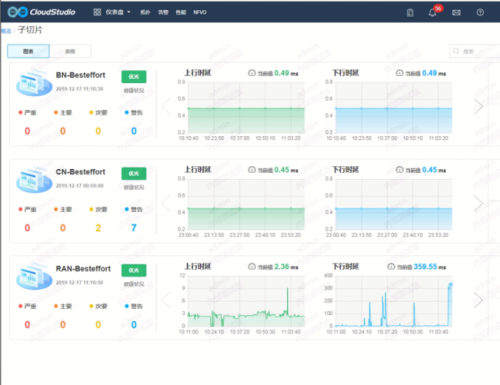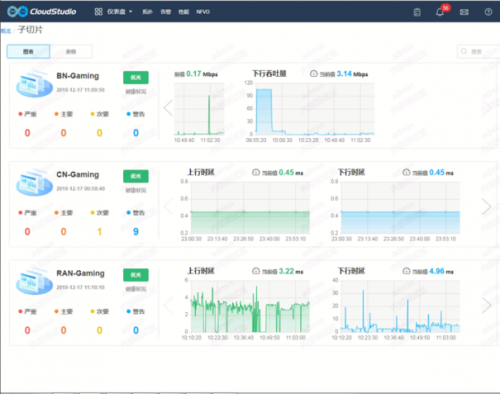Introduction
Network Slicing is a key technology in the 5G era and offers reliable network quality. With Network Slicing, China Unicom can provide an end-to-end dynamic business guarantee to cloud gaming, making it possible to play online games whenever and wherever.
China Unicom operates GSM, WCDMA, FDD-LTE and 5G mobile network businesses. At the end of 2019, China Unicom has 324 million customers. In 2019, China Unicom launched 5G scale trials in Shanghai, Shenzhen, Wuhan and Shijiazhuang based on stand-alone (SA) architecture. Demonstrations of typical 5G scenarios were carried out, providing a foundation for the early commercial availability of the 5G network in 2019 and large-scale commercial expansion in 2020. With the advantage of 5G SA, China Unicom plans to increase industrial co-operation and expand various applications.
For the industry business market, China Unicom has launched strategic co-operation agreements with a number of enterprises, such as Tencent and BMW. In addition, China Unicom partnered with 32 partners to establish the China Unicom 5G Application Innovation Alliance. The Alliance leverages the ecosystem players to lead the rapid development of 5G applications.
Commercial demand
Cloud Gaming refers to games played remotely on cloud computing. Cloud games operate fully on the server side where images are rendered, compressed and transmitted through the network to the user. This means that players do not require high-performance hardware, but only enough performance to decompress the video. However, cloud games demand a high network performance, especially in terms of network latency. In terms of the concept of Cloud Games, “cloud technology” is the core, and the network requirements underlie this. After computing through the cloud server, the data needs to be transmitted through the network, where a poor quality network will lead to lagging images or out of sync operation of the game. When the network delay is longer than 20 milliseconds, the user’s experience of the game will degrade significantly. When the network delay is longer than 30 milliseconds, it is virtually impossible to play the game.
It is difficult for traditional 3G/4G networks to meet such extreme network delay requirements. Furthermore, the wireless resource is managed only by QoS (Quality of Service) in 3G/4G networks, which only offers a limited range of service quality. Network slicing technology in 5G can support the specific needs of the business. This is done by end-to-end slicing of access networks, core networks and transmission networks, combined with new enhancements for vertical industry architecture. Based on network slicing, resources can be allocated for specific services to ensure the quality of the cloud game experience is high and it is, therefore, possible to guarantee and prioritize a ‘Cloud Game’ slice when users simultaneously play games in the cloud.
Solution
China Unicom has implemented a new 5G SA network, including 5G NR, core network, bearing network, and built an end-to-end slicing environment in Shenzhen.
In 2019, China Unicom, together with ZTE and Tencent, conducted a technical verification of end-to-end network slicing over the 5G network in Shenzhen. It was intended to verify the technical architecture, deployment mode, business assurance and business model of end-to-end network slicing. Based on the end-to-end slicing architecture of wireless priority, flex-e and core network slice, the objectives were to:
- Demonstrate the differentiated business guarantee capability of network slicing
Verify the feasibility of end-to-end network slice technology architecture: including end-to-end slicing design, deployment, service provisioning and monitoring.
Connect to Tencent cloud game platform:
- Demonstrate a dynamic slice guarantee based on user and location
- Show the innovative operation mode of slices

Performance
Through the comparison between ordinary users using ordinary slices and VIP users using exclusive slices, the performance parameters below show the guarantee of VIP users’ high-quality business experience.

Figure 1. Ordinary user with interference

Figure 2. VIP slice with interference
Development of Network Slicing
Since 2015, 3GPP (3rd Generation Partnership Project) has been formulating specifications related to 5G network slicing. It completed the formulation of a basic functional framework and enhanced functional requirements in Releases 15 and 16 respectively. As an important technology of 5G, network slicing has been highly valued by 3GPP. A number of working groups within the scope of 3GPP have corresponding research and standardization projects on network slicing technology, including scene research of SA1, framework formulation of SA2 and network management of SA5, etc. In addition, in terms of market demand and commercial implementation, the GSMA has conducted research on network slicing business requirements, business scenarios and slicing templates through the original NEST project team since 2017. It has delivered relevant whitepapers and commercial profiles such as GSMA PRD NG.116.
Conclusion
Network slicing is a key technology of 5G, and also a core enabler for China Unicom to expand to vertical industries. Network slicing enables business customers to select the features required by their applications, which helps to improve the efficiency of the network and the customers’ experience. Cooperation with Tencent is an example of end-to-end implementation of 5G network slicing, which is not only an important step in the strategic cooperation between China Unicom and Tencent but also demonstrates an insightful application of 5G in vertical industries.
